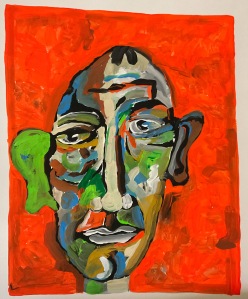There is a place between the intellectual and emotional aspects in the making of a piece of art. It is here that the search for truth may be exposed and explored. Composition, line, color, and technique are manipulated in a intellectual way with reference to the rules of, or against art history. The classical problems of art. While the emotional aspect comes from a visceral experience of the painting. Here, sometimes apparent elements of accident may appear. I don’t see this as accident but subconscious effect. Tying into a personal language at the root of the subconscious. At the intersection of the two is a place where truth may be found. This is where emotional honesty is required, coming from the soul and of the artist. From the deepest memory or experience. Here the intellect should not overwhelm the emotional, but work to support it. Brushstroke by brushstroke the painting is made, in line and color, establishing it’s own reality. There is an illusion of space in the two dimensional plane. This is where two compositions work together and in discord with each other. This creates a tension in the piece, a kind of caged energy. An illusion of movement. Mine is a stylized realism, an unreal depiction of the figure, and the use of personal symbols. I try to keep the viewer off balance, to have a unique experience. To engage one to the open message of the work. My main concern is in an emotional reality.
The initial composition is but a starting point, a framework for the support of the use of personal symbols and color choices. If I invert figures or make odd juxtapositions of elements it is to keep the viewer
Engaged. To upset the expected. I am interested in imperfection, the flaws that create interesting relationships. The flaw in human emotion in a physical world, the emotional response in the material aspect. My aim is to exploit this balance, through harmony or discordant employment of elements.
While my work is influenced by many artists, my most prominent influences are the works of Phillip Guston, Jean Michel-
Basquiat, Georg Baselitz, and Lucien Freud. These are the artists I study, each in their own way, breaking the historical rules of art. I am also greatly influenced by the works of Sartre, Dostoevsky, Cormac McCarthy, Martin Amis, Julian Barnes, Nelson Algren, Jose Saramago, and John Steinbeck among many others.
I consider myself to be an atheistic existential humanist, with anarchist leaning. I’ve always been drawn to social realism, to the dark side of humanity. To real unabashed experience. This experience permeates my work.
